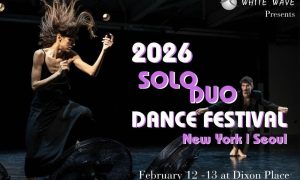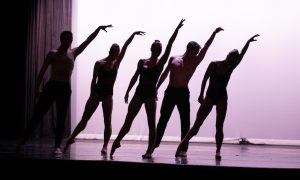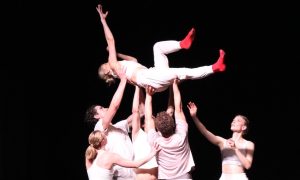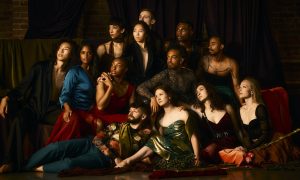May 2020.
Online at newdancealliance.org.
Pandemic times mean that in-person dance festivals are absolutely out of the question. Rather than fully give into these limitations and the resulting disappointment, many festivals have shifted to virtual festivals, including Performance Mix Festival through the New Dance Alliance. Cleverly reflecting the times, they titled this 34th iteration of the festival Remotely Yours. The festival featured a different performer for each day of the month — with a video of their work, a biography, an artist statement and the artist’s contact information. This reviewer appreciated learning about various tri-state area performers, with the festival offering a month’s worth of space for various artists to show their work and have a voice. The flexible scheduling also allowed me to take in more work than I would likely be able to in the “before (COVID) times.”
All of that considered, such a shift to a virtual platform has implications for the dance art at hand that go beyond the medium through which audience members receive it, and perhaps when they do so. What new possibilities, and on the other hand limitations, does dancing on camera confer? How might audiences, and even the nature of performers in the spotlight, shift? In a socially-distanced world, how does choreography change — in aspects such as spacing, numbers of dancers, spatial choices and the like?
What might it mean to engage with an imagined, implicit audience versus one who is right in front of you as a performing artist? How might dance on camera and even live dance (when we can return to it) evolve as a result of creative activity happening during this time? One festival will not answer these questions, but they can add to the conversation. They remain open questions, ones that are meaningful for how this art form goes forward.
May 4
Brooklyn-based NOT FOR reTALE, under Artistic Director Emily Smith, is a concoction of sharp angles, sharp sounds and sharp movements. It seems more performance art than dance performance, per-se. Smith cites “surreal sensibility” in her artist statement, and she delivers it here. By their jerky and confined movements, dancers appear somehow caught by the poles protruding from their sleek, skintight costumes in an “x” behind them. While the abrasive aesthetic quality isn’t personally my cup of tea to experience, the work begins to surface astute questions on modernity, technology, and modern confinement of the human soul (the female soul, in particular; interestingly, all of the dancers are women).
May 5
In movement and other visual aspects, Maya Orchin appears to be quite interested in the tension between sharp and soft, circular and angular, aesthetic definition and the lack thereof. Her three different videos speak to different states of experience during coronavirus — a haziness with acute points, a dejectedness with a ray of energetic joy, and moving outside with a mask on. It;s intriguing to me to think how these portrayals and her interest in duality may be linked; while living through this epidemic is incredibly challenging for many of us, we’re also finding all sorts of silver linings — opportunity out of adversity.
May 11
Birgit Larson’s Fetish of the Ex is a “performative exploration of the relationship with her ex’s fiance.” In it, she moves on a bed, in a bra and panties, doing a sort of dance with a dress — covering herself with it and uncovering, putting it on and taking it off. What I find most interesting is the spatial relationship of her and the dress, and how her small movements change that relationship. While the small and nuanced nature of these movements intrigues me, I do wonder how larger and clearer movements could have created an energetic rise and fall. Even so, I’m compelled by how a spare presentation — with one person, a bed, and a dress — can have so much visual intrigue and symbolic meaning.
May 13
Collaborators Emily LaRochelle and Sarazina Joy Stein offer movement in outdoor spaces with natural purity, but also evidence of human manicuring of it (such as mowed lawns, benches, pruned trees and the like). They move with joy, ease, at times a pinch of physical comedy, and sometimes even a sprinkle of capoeira-like kinespheric physics. The way they fluidly respond to each other’s movement indicates that they’re improvising — and beautifully so. Their clothing, somewhat plain and functional, is layered — evincing a chill in the air. The only score is their breath and the crunch of leaves and other natural debris below their boots. I feel the chilly air in my lungs and wind blowing on my face; the naturalism is so pure that it brings me right there with them. At a time when so many of us feel disconnected from freely exploring nature, with those we love, LaRochelle and Joy Stein’s offering feels like nothing short of healing.
May 14
Kameron Chatman’s In and Out begins gradually, but asserts itself before long. A presentation of one solo performer, with simple costume and lighting palette, and a score of silence, creates a starkness and clarity that is refreshing. The movement holds a lot of richness and complexity, however. Chatman’s artist statement describes how for her, the soloist came to represent communities “outside of the social barrier of whiteness.” In its rooting in the earth, feeling of groove, and unapologetic soulfulness, there is indeed something quite culturally Black about her movement — and beautifully so.
At the same time, movement of retreat and self-protection reveal a more sinister side to that experience. Strikingly, one dancer moving while supported with spare supportive artistic elements probes into matters that could (and do) fill volumes — all without words. The courage to move in one’s experience and truth can have that kind of power.
May 18
Degenerate Art Ensemble presents Remotely Yours, a twenty-two minute dance film made especially for this online festival. The film opens with a mesmerizing blend of movement, shadow, and ambient score. It is as if the protagonist dances behind a large cloth, and it is endlessly intriguing for the eyes to distinguish where she moves and where her shadow falls on the cloth. The film cuts to a parking lot of some sort, and her movement quality becomes much more accented. In a striking visual, four cars circle her and she continues to dance. There’s something catlike to her movement and presence, strikingly pliable but also with a strength of conviction and grounding in her place. I wonder if the camera panning in tighter would have brought us further into her experience, as well as if the music picking up volume or intensity could have helped build further drama here.
Later, she dances directly in the headlights of these cars. I think about being seen, “caught in the headlights”, one’s primal and organic truth meeting technology and socialization. Later she dances in a more wide-open space, a natural space that nevertheless has signs of urban life (skyscrapers in the background, sections of concrete along with those of grass, for instance). In a sort of Goldilocks construct, perhaps she had found her happy Medium in that last place. As she returns to dancing behind the curtain, I wonder if it was all a dream. Something about it all is surreal and dreamlike. Whatever it might depict, the aesthetic qualities of this work captivate me — and thus put me into a place to receive its cogent queries on life as we know it.
By Kathryn Boland of Dance Informa.













